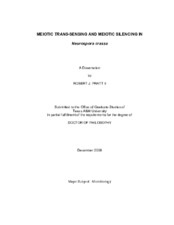| dc.description.abstract | Meiosis, the core engine of sexual reproduction, is a complex process that
results in the production of recombinant haploid genomes. In the meioses of
Neurospora, worms and mice, gene expression from DNA that lacks a pairing
partner is silenced. We posit that this is a two-step process. First, a process
called meiotic trans-sensing compares the chromosomes from each parent and
identifies significant differences as unpaired DNA. Second, if unpaired DNA is
identified, a process called meiotic silencing inhibits expression of genes within
the unpaired region and regions sharing sequence identity. Meiotic silencing is
mechanistically most likely related to RNAi in other eukaryotes.
We used a combination of forward and reverse genetic strategies aimed at
understanding the mechanisms of meiotic trans-sensing and meiotic silencing.
Here, we present genetic evidence that arguably differentiates the meiotic transsensing
step from meiotic silencing, by demonstrating that DNA methylation
affects sensing of specific allele-types without interfering with silencing in
general. We also determined that DNA sequence is an important parameter
scrutinized during meiotic trans-sensing. This, and other observations, led us to
hypothesize meiotic recombination as the mechanism for meiotic trans-sensing.
However, we find that mutants of key genes required for recombination and
chromosome pairing are not required for locus-specific meiotic silencing. We
conclude that two interesting possibilities remain: meiotic trans-sensing occurs through a previously uncharacterized recombination pathway or chromosomal
regions are carefully compared in the absence of recombination. Finally,
forward genetics revealed a novel component of meiotic silencing, Sms-4,
encoding the Neurospora ortholog of mammalian mRNP component ELG
protein. Unlike previous loss-of-function mutants that abate meiotic silencing by
unpaired DNA, Sms-4 is not required for successful meiosis, showing that
meiosis and meiotic silencing are distinct, yet overlapping, phenomena.
Intriguingly, SMS-4 is the first component to be localized with bulk chromatin in
the nucleus, presumably the site of trans-sensing. Finally, we carried out a
critical examination of the current evidence in the field and present alternative
models for meiotic trans-sensing and meiotic silencing in Neurospora. | en |


